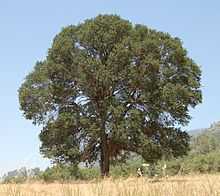Quercus douglasii
- For the school in Napa County, California named after Blue Oaks, see Blue Oak School.
| Quercus douglasii Blue Oak | |
|---|---|
 | |
| A large Blue Oak in a pasture in Mariposa County, California. | |
| Scientific classification | |
| Kingdom: | Plantae |
| (unranked): | Angiosperms |
| (unranked): | Eudicots |
| (unranked): | Rosids |
| Order: | Fagales |
| Family: | Fagaceae |
| Genus: | Quercus |
| Section: | Quercus |
| Species: | Q. douglasii |
| Binomial name | |
| Quercus douglasii Hook. & Arn. | |
 | |
| Natural range | |
Quercus douglasii, known as Blue Oak, is a species of oak endemic to California, common in the Coast Ranges and foothills of the Sierra Nevada.[1] It is occasionally known as Mountain Oak and Iron Oak.[2]
Description
Q. douglasii is a medium-sized tree, generally 6–20 m (20–66 ft) tall, with a trunk 36–60 cm (1.18–1.97 ft) in DBH.[3] The tallest recorded specimen was found in Alameda County, at 28.7 m (94 ft).[4] The bark is light gray with many medium-sized dark cracks; from a distance, it can appear almost white. The name Blue Oak derives from the dark blue-green tint of its leaves, which are deciduous, 4–10 cm (1.6–3.9 in) long, and entire or shallowly lobed. The acorns are 2–3 cm (0.79–1.18 in) long,[5] with a moderately sweet kernel, and mature in 6–7 months from pollination.
Ecology
Q. douglasii prefers dry soil and plenty of sunlight. It is the most drought tolerant of California's deciduous oaks.[3]
Q. douglasii often codominates with Gray Pine (Pinus sabiniana), and is also found with Interior Live Oak (Q. wislizeni), Valley Oak (Q. lobata), Oregon White Oak (Q. garryana),[3] Canyon Live Oak (Q. chrysolepis), and Pacific Madrone (Arbutus menziesii). Natural hybrids between Q. douglasii and the related Shrub Live Oak (Q. turbinella), Q. lobata, and Q. garryana often occur where the species grow together in the same area.
Individual trees over 500 years old have been recorded, although most are less than 300 years old. Recent research has found several unlogged stands of Blue Oak woodlands, suggesting that the state may harbor over 500,000 acres (200,000 ha; 2,000 km2) of such old-growth forests.
Q. douglasii is susceptible to sudden oak death, though less so than Tanoak (Notholithocarpus densiflorus), or red oaks such as Coast Live Oak (Q. agrifolia).
See also
| Wikimedia Commons has media related to Quercus douglasii. |
References
- ↑ iGoTerra—Blue Oak (Quercus douglasi)
- ↑ Philip M. McDonald, USDA
- ↑ 3.0 3.1 3.2 Fryer, Janet L. 2007. Quercus douglasii. U.S. Department of Agriculture, Forest Service, Rocky Mountain Research Station, Fire Sciences Laboratory (Producer).
- ↑ http://www.dfg.ca.gov/biogeodata/cwhr/pdfs/BOW.pdf
- ↑ Flora of North America: Quercus douglasii
Further reading
- Stahle, David. "Ancient Blue Oak Woodlands of California". University of Arkansas Tree-Ring Laboratory. Retrieved 2008-11-10.
- Peterson- Raptors of California